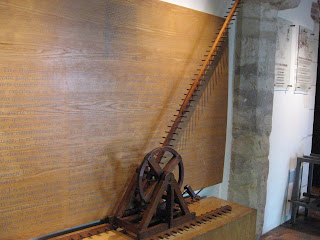
The Château du Clos Lucé stands in the pleasant valley of the Amasse, a small tributary of the Loire.
The main building is organized around an octagonal corner tower containing a spiral staircase, with two 3-storey buildings at right angles. The elegant façade of pink brick and tufa stone bears the architectural stamp of the 15th century.
François I, who treated Leonardo with great honour, appointed him "First painter, architect and engineer of the King". He made this residence available to him, as well as a princely pension of 700 gold Ecus a year and the King paid for his works, asking nothing in return but the pleasure of hearing him talk, a pleasure he enjoyed almost every day.
The château is surrounded by a vast green and shady park. Bought by Charles VIII on July 2, 1490, it was a royal residence and summer residence of the Kings of France for 200 years.
Château du Clos Lucé is filled with the beautiful items that would have surrounded Leonardo.
The Chapel.

Leonardo da Vinci's bed and the rooms he occupied for the last three years of his life. This is where he wrote his will on April 23, 1519, leaving his manuscripts and his notebooks of drawings and sketches to his beloved disciple, Francesco Melzi. This is also the room where he died on May 2, 1519, at the age of 67.
An 18th-century earthenware fountain representing Bacchus sitting on a barrel.


The hall where Leonardo da Vinci was received, with XV century furniture.

The original Mona Lisa is in the Musée du Louvre in Paris.
This is the realm of Mathurine, the vegetarian Leonardo Da Vinci's cook.

Leonardo is known as a painter, but he was also an inventor and a scientist. The following are but a sampling of what he invented.
An "escalator" transferring circular motion to vertical motion.
A futuristic assault tank.
A machine gun.
Design for a paddle-wheeler.
Swing Bridge.
Double hull for ships.
Cogs.
Bicycle and automobile.

Leonardo had thoughts on the Art of Flying.

The helicopter.
The Mill.

Double level bridge.
Leonardo was also a botanist and painted many plants with incredible accuracy. The flowers found in his paintings, often next to hands, are beautiful and precise.



























No comments:
Post a Comment